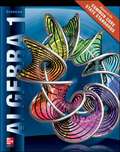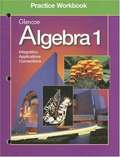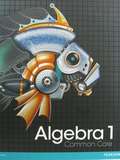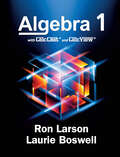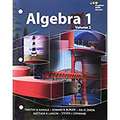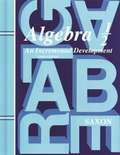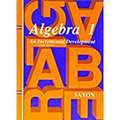- Table View
- List View
Algebra 1 (Student Edition CCSS)
by Glencoe McGraw-Hill StaffAlgebra 1 helps students prepare for algebra and is set according to Common Core State Standards(CCSS).
Algebra 1 Practice Workbook
by Glencoe McGraw-Hill StaffThis Practice Workbook gives you additional practice for the concept exercises in each lesson. The Practice exercises are designed to aid your study of mathematics by reinforcing important mathematical skills needed to succeed in the everyday world. The material is organized by chapter and lesson with one practice worksheet for every lesson in Algebra 1.
Algebra 1 [Grade 8/9]
by Inc Prentice-Hall Randall Inners CharlesPearson is proud to offer a NEW Common Core Edition of the same great high school mathematics program that has already been proven effective by an independent research study. The new program fully addresses the Common Core Content Standards and infuses the Standards for Mathematical Practice throughout every lesson.
Algebra 1 for Christian Schools (2nd edition)
by Kathy D. Pilger Ron TagliapietraThe Arabic word al-jabr from which we get our word algebra carries the idea of the reunion of broken parts, such as the reduction of fractions to whole numbers. Algebra takes the fragmentary information of a word problem, symbolizes it in abstract form, and derives the answer. Algebra is a structured system for expressing and analyzing the relationships between quantities that may themselves be unknown. The resulting formulas, equations, and expressions are built from symbols, numbers, and operations. The power of algebra is seen when we determine an unknown quantity simply by manipulating the symbols. Algebra is a worthwhile study for all students. Even trades use computers or other tools that depend on algebra, and the most effective use of such tools requires an understanding of what it does. The study of a subject such as algebra requires diligent effort, but it provides either specific skills or practical background knowledge for every type of work. Furthermore, the diligent development of mental discipline has its own rewards
Algebra 1, Practice Book
by Alfred S. Posamentier Catherine D. Letourneau R. James MilgramA publisher-supplied textbook
Algebra 1, Practice and Problem Solving Workbook
by Prentice HallThis book contains Algebra practice exercises and answers.
Algebra 1, Sourcebook
by Alfred S. Posamentier Catherine D. Letourneau R. James MilgramA publisher-supplied textbook
Algebra 1, Student Companion
by Prentice HallPrentice Hall Algebra 1 program is designed to help students achieve mastery of Algebra 1 topics.
Algebra 1, Student Text and Homework Helper
by Randall I. Charles Allan E. Bellman Basia HallNIMAC-sourced textbook
Algebra 1, Third Edition
by Mark Wetzel Gene Bucholtz Tamera Knisely Larry HallAlgebra 1, Third Edition focuses on the integration of algebraic concepts in technology and real-life applications, presenting topics in logical order with detailed examples that promote student comprehension and retention. Students explore the simplification, solving, graphing and interpretation of linear, exponential, radical, quadratic, and rational functions both manually and with technology.
Algebra 1, Wisconsin, Student Edition
by Ron Larson Laurie Boswell Lee Stiff Timothy D. KanoldThe content of Algebra 1 is organized around families of functions, with special emphasis on linear and quadratic functions. As you study each family of functions, you will learn to represent them in multiple ways--as verbal descriptions, equations, tables, and graphs. You will also learn to model real-world situations using functions in order to solve problems arising from those situations. In addition to its algebra content, Algebra 1 includes lessons on probability and data analysis as well as numerous examples and exercises involving geometry. To help you prepare for standardized tests, Algebra 1 provides instruction and practice on standardized test questions in a variety of formats--multiple choice, short response, extended response, and so on.
Algebra 1/2: An Incremental Development (3rd Edition)
by John SaxonThe Algebra 1/2 course focuses on introductory algebra topics. It is designed to facilitate your transition from the concrete concepts of arithmetic to the abstract concepts of algebra. One feature of Algebra 1/2 that you will find particularly useful is the lesson reference numbers in the problem sets. Beneath each problem number in the problem sets is a number in parentheses; this number refers to the lesson where the concepts and skills required to solve the problem are introduced. Should you have difficulty solving a particular problem, refer to the appropriate lesson for assistance.
Algebra 1: A Reference Guide
by K12 Summit CurriculumIn this book, students explore the tools of algebra. Students learn to identify the structure and properties of the real number system; complete operations with integers and other rational numbers; work with square roots and irrational numbers; graph linear equations; solve linear equations and inequalities in one variable; solve systems of linear equations; use ratios, proportions, and percentages to solve problems; use algebraic applications in geometry, including the Pythagorean theorem and formulas for measuring area and volume; complete an introduction to polynomials; and understand logic and reasoning.
